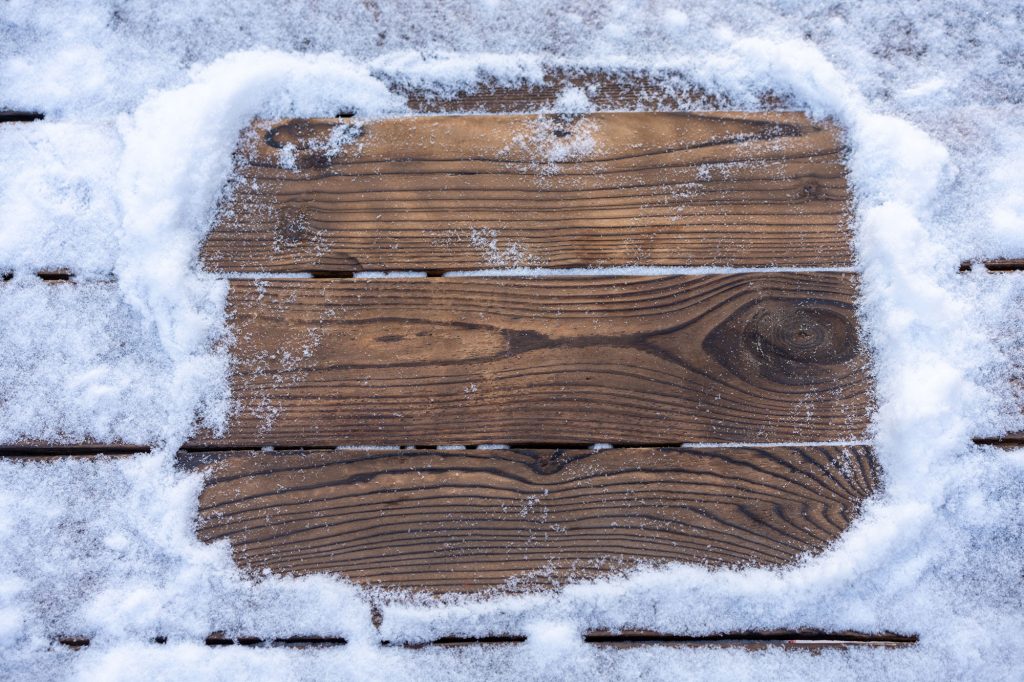Winter Decks
Winterizing Your Deck: Preparation and Maintenance Tips
As winter approaches, it’s essential to prepare your deck to withstand the harsh conditions that cold weather can bring. Snow, ice, and freezing temperatures can take a toll on your deck, leading to damage if it’s not properly protected. Winterizing your deck can help prolong its lifespan, prevent costly repairs, and ensure it’s ready for enjoyment when warmer weather returns. Here’s a guide to preparing and maintaining your deck for the winter months.

Clear and Clean Your Deck
Before the winter weather arrives, start by giving your deck a thorough cleaning. Remove any furniture, planters, rugs, and decorations so you have a clear surface to work with. Sweep away leaves, dirt, and other debris that have accumulated, as this debris can trap moisture against the deck’s surface, which can lead to mold, mildew, and rot.
For a deeper clean, use a mild deck cleaner or a mixture of water and soap to scrub the surface. For wood decks, use a soft-bristle brush to avoid scratching the surface. Make sure to rinse thoroughly with a garden hose, and let the deck dry completely. This step is crucial as any lingering moisture can freeze and expand, causing damage to the deck material.
Inspect for Damage
Once your deck is clean, inspect it for any signs of damage or wear. Look for loose boards, protruding nails, cracks, or splinters, especially on wood decks. These minor issues can worsen over the winter as moisture seeps into cracks and expands when frozen. Replace any damaged boards, tighten screws, and hammer down any loose nails to ensure the deck is safe and sturdy.
If you have a composite or vinyl deck, check for any scratches or dents, and consult the manufacturer’s guidelines on any necessary repairs. Addressing these minor issues now will prevent them from becoming major problems during the winter.


Apply a Protective Sealant
Applying a sealant is one of the most effective ways to protect your deck from winter weather. For wood decks, a high-quality water-repellent sealant will help prevent moisture from penetrating the wood, reducing the risk of swelling, warping, and rot. Sealants should ideally be applied in the fall before the temperatures drop below 50°F, as they need time to properly cure and bond with the wood.
If your deck is made of composite or vinyl, check the manufacturer’s recommendations on winterizing. These materials are generally more resistant to moisture, but a protective coating can still help keep your deck looking its best.
Protect Deck Hardware and Railings
Don’t forget about the hardware and railings on your deck. Metal components, such as screws, nails, and brackets, can corrode over time when exposed to moisture. If you have metal railings, consider applying a rust-resistant finish to protect them from the elements.
Wooden railings should be cleaned and sealed just like the deck boards, while composite or vinyl railings may require a specific type of cleaner. Check for any loose or wobbly railings, and tighten or replace hardware as needed to ensure stability and safety throughout the winter months.


Trim Overhanging Branches
Overhanging branches can pose a threat to your deck in the winter, especially if they’re weighed down by snow or ice. Trim back any branches that hang over your deck to prevent them from breaking off and causing damage to the deck boards or railings. This simple step can also help reduce the amount of leaves and debris that fall onto your deck, keeping it cleaner and reducing the risk of trapped moisture.
Avoid Heavy Snow Accumulation
While your deck is built to withstand a certain amount of weight, heavy snow accumulation can put unnecessary stress on the structure. After a heavy snowfall, use a broom or a plastic snow shovel to gently remove snow from your deck. Avoid using metal shovels, as they can scratch and damage the surface of the deck, especially if it’s made of wood or composite materials.
When shoveling, move in the direction of the deck boards to avoid catching or lifting any boards. Clearing snow regularly will not only protect the deck but also make it easier to maintain traction and prevent ice buildup.


Use Pet-Safe, Non-Corrosive Ice Melt
When icy conditions develop, many homeowners turn to rock salt or traditional ice melts, but these products can be harsh on deck materials and potentially harmful to pets. Choose a pet-safe, non-corrosive ice melt designed for decks to prevent slipping hazards without damaging the surface.
For wood decks, avoid calcium chloride, as it can stain the wood and cause discoloration. Instead, look for magnesium chloride-based products, which are gentler on wood, composite, and vinyl decking. Scatter the ice melt lightly and sweep up any excess once the ice has melted to keep your deck clean and safe.
Cover and Protect Outdoor Furniture
If you plan to leave outdoor furniture on your deck, make sure it’s covered and properly secured to prevent moisture buildup and protect it from the elements. Investing in high-quality furniture covers will help prevent damage from snow and ice. Alternatively, consider storing furniture in a shed or garage to free up space and reduce wear and tear on your deck.
Planters, rugs, and other decorative items should also be removed from the deck to prevent moisture from becoming trapped underneath, which can lead to staining or mold growth.


Schedule Regular Maintenance Checks
Throughout the winter, periodically check your deck to make sure it’s still in good condition. Look for any signs of water pooling, ice buildup, or loose boards, and take action if necessary. Regular checks will allow you to catch small problems before they turn into costly repairs.
Winterizing your deck doesn’t have to be a complicated process, but it does require some preparation and maintenance. By taking the time to clean, inspect, and protect your deck before winter, you can ensure it remains safe, beautiful, and ready for use once the warmer months arrive. Whether your deck is made of wood, composite, or vinyl, these winterization steps will help preserve its appearance and structural integrity, allowing you and your family to enjoy it for years to come.
At River Valley Construction Group, we’re here to help you protect your investment and keep your deck in top shape. If you have questions about deck maintenance or are considering upgrades for your outdoor space, don’t hesitate to contact us. Our experts can help you winterize and prepare your deck for any season, ensuring it remains a valuable part of your home.
If you have more questions regarding building a custom home, feel free to give us a call – we’re more than happy to address any concerns you have as well as provide you with a fair quote for the job: (574) 210-5951
